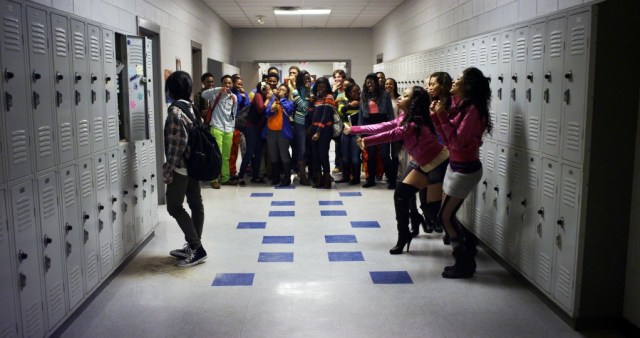“A Girl Like Grace” screened at this years LAFF as part of the “Zeitgeist” category. Ryan Distiny‘s character Grace is exceptionally bright but confined and suffocated with a somewhat disinterested fun loving single mother Lisa who is played by Garcelle Beauvais. The movie narration refers to Lisa as a “Haitian Princess”, that reference breathes into her character a sense of entitlement and narcissism breeds Grace’s lack of self-esteam, reserve and disenfranchisement from her familial bond. “A Girl Like Grace” revolves around Grace’s downward spiral after the loss of her best friend, that intertwines her budding teenage sexuality and dissociative behaviors that drives her to experiment with passionless sex and drug use.
The movie tries some interesting cinematographic choices and story telling. I found some of the close-up choices created a nice distorted forced uncomfortable closeness in the story telling. The lesbian themes with a “Mean Girls” tilt in the film, that was embodied in Mary, Raven-Symoné‘s cheerleader persona, was a nice counter point to Grace’s somber and sober presence. But the disjointed and confusing lesbian themed montage near the end of the movie didn’t read well or clearly enough to distill how Grace’s friend Andrea, played by Paige Hurd, chose the path of suicide.
Like any coming of age stories there are as many tangled threads, as there are those that remain untethered. Grace becomes friendly with Meagan Good’s character Share, who’s Andrea‘s older sister in the movie. Share introduces Grace to the underworld of thuggery, drug and passionless sex. Grace disconnects from the bright studious girl we meet in the beginning of the movie to replace all that potential with a sexy party girl persona after being de-flowered by Romeo Miller’s character, Jason, as she locks into a careless bender that leads form boy to boy to girl. This the darkest moment in the film is when Grace chooses to lose her sense of self: abandoning all her amazing potential to dumb it down party girl in and endless cycle of hopelessness and poverty that had entrapped her mother as a girl. In the preceding moments it becomes exceedingly clear Grace could get locked in generational cycle that her mother is yet to be liberated from and could possibly doom her own future of opportunities.
While Grace’s world is falling apart her mother, Lisa, has a couple of tryst that leads to ill effect. These ensuing events proved the back story on Lisa and Grace that clearly defines the scope of the story and leads to greater depth in the story. Their madness drives for the last third of the story. The breaking point comes when Grace can no longer sustain her vapid and senseless pursuits with a series of really surprising negative moments. Lisa has come to her senses and has faced her own reckoning of sorts that makes her more open to her daughter’s needs. Once the two are joined again as mother and daughter there are emotional moments of reconciliation and redemption that humanizes them both in a meaningful familial way.




